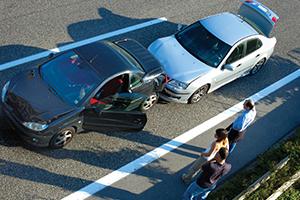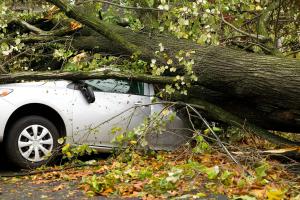Reducing distractions to increase pedestrian safety

Roadway safety is not limited to the person behind the wheel.
Distracted walking while using a cell phone or listening to music with headphones are digital safety concerns that contribute to a growing trend of incidents involving pedestrians.
The Centers for Disease Control and Prevention estimated more than 181,000 pedestrians were injured in 2018 – ranging from minor scrapes and cuts to life-threatening conditions. A study by the Governors Highway Safety Association revealed that pedestrian deaths in 2019 was the highest single-year total in more than three decades.
Street safety – a shared responsibility
To minimize risk:
Drivers should… |
Walkers should… |
|---|---|
|
|
Protect yourself and those around you
In addition to following traffic laws and safe driving recommendations, it's important to have the right insurance protection should an accident occur. Reach out to your independent insurance agent to be sure you have the right liability limits on your auto insurance, and discuss whether you should add an umbrella policy to your coverage for added peace of mind.
Sources:
Governors Highway Safety Association
National Highway Traffic Safety Administration
Centers for Disease Control and Prevention
This material is provided for informational purposes only and does not provide any coverage or guarantee loss prevention. The examples in this material are provided as hypothetical and for illustration purposes only. The Hanover Insurance Company and its affiliates and subsidiaries (“The Hanover”) specifically disclaim any warranty or representation that acceptance of any recommendations contained herein will make any premises, or operation safe or in compliance with any law or regulation. By providing this information to you, The Hanover does not assume (and specifically disclaims) any duty, undertaking or responsibility to you. The decision to accept or implement any recommendation(s) or advice contained in this material must be made by you.
LC 2020-660
Related resources
Reducing distractions to increase pedestrian safety
Roadway safety is not limited to the person behind the wheel.
Distracted walking while using a cell phone or listening to music with headphones are digital safety concerns that contribute to a growing trend of incidents involving pedestrians.
The Centers for Disease Control and Prevention estimated more than 181,000 pedestrians were injured in 2018 – ranging from minor scrapes and cuts to life-threatening conditions. A study by the Governors Highway Safety Association revealed that pedestrian deaths in 2019 was the highest single-year total in more than three decades.
Street safety – a shared responsibility
To minimize risk:
Drivers should… |
Walkers should… |
|---|---|
|
|
Protect yourself and those around you
In addition to following traffic laws and safe driving recommendations, it's important to have the right insurance protection should an accident occur. Reach out to your independent insurance agent to be sure you have the right liability limits on your auto insurance, and discuss whether you should add an umbrella policy to your coverage for added peace of mind.
Sources:
Governors Highway Safety Association
National Highway Traffic Safety Administration
Centers for Disease Control and Prevention
This material is provided for informational purposes only and does not provide any coverage or guarantee loss prevention. The examples in this material are provided as hypothetical and for illustration purposes only. The Hanover Insurance Company and its affiliates and subsidiaries (“The Hanover”) specifically disclaim any warranty or representation that acceptance of any recommendations contained herein will make any premises, or operation safe or in compliance with any law or regulation. By providing this information to you, The Hanover does not assume (and specifically disclaims) any duty, undertaking or responsibility to you. The decision to accept or implement any recommendation(s) or advice contained in this material must be made by you.
LC 2020-660
Related resources
Reducing distractions to increase pedestrian safety
Roadway safety is not limited to the person behind the wheel.
Distracted walking while using a cell phone or listening to music with headphones are digital safety concerns that contribute to a growing trend of incidents involving pedestrians.
The Centers for Disease Control and Prevention estimated more than 181,000 pedestrians were injured in 2018 – ranging from minor scrapes and cuts to life-threatening conditions. A study by the Governors Highway Safety Association revealed that pedestrian deaths in 2019 was the highest single-year total in more than three decades.
Street safety – a shared responsibility
To minimize risk:
Drivers should… |
Walkers should… |
|---|---|
|
|
Protect yourself and those around you
In addition to following traffic laws and safe driving recommendations, it's important to have the right insurance protection should an accident occur. Reach out to your independent insurance agent to be sure you have the right liability limits on your auto insurance, and discuss whether you should add an umbrella policy to your coverage for added peace of mind.
Sources:
Governors Highway Safety Association
National Highway Traffic Safety Administration
Centers for Disease Control and Prevention
This material is provided for informational purposes only and does not provide any coverage or guarantee loss prevention. The examples in this material are provided as hypothetical and for illustration purposes only. The Hanover Insurance Company and its affiliates and subsidiaries (“The Hanover”) specifically disclaim any warranty or representation that acceptance of any recommendations contained herein will make any premises, or operation safe or in compliance with any law or regulation. By providing this information to you, The Hanover does not assume (and specifically disclaims) any duty, undertaking or responsibility to you. The decision to accept or implement any recommendation(s) or advice contained in this material must be made by you.
LC 2020-660
Related resources
Reducing distractions to increase pedestrian safety
Roadway safety is not limited to the person behind the wheel.
Distracted walking while using a cell phone or listening to music with headphones are digital safety concerns that contribute to a growing trend of incidents involving pedestrians.
The Centers for Disease Control and Prevention estimated more than 181,000 pedestrians were injured in 2018 – ranging from minor scrapes and cuts to life-threatening conditions. A study by the Governors Highway Safety Association revealed that pedestrian deaths in 2019 was the highest single-year total in more than three decades.
Street safety – a shared responsibility
To minimize risk:
Drivers should… |
Walkers should… |
|---|---|
|
|
Protect yourself and those around you
In addition to following traffic laws and safe driving recommendations, it's important to have the right insurance protection should an accident occur. Reach out to your independent insurance agent to be sure you have the right liability limits on your auto insurance, and discuss whether you should add an umbrella policy to your coverage for added peace of mind.
Sources:
Governors Highway Safety Association
National Highway Traffic Safety Administration
Centers for Disease Control and Prevention
This material is provided for informational purposes only and does not provide any coverage or guarantee loss prevention. The examples in this material are provided as hypothetical and for illustration purposes only. The Hanover Insurance Company and its affiliates and subsidiaries (“The Hanover”) specifically disclaim any warranty or representation that acceptance of any recommendations contained herein will make any premises, or operation safe or in compliance with any law or regulation. By providing this information to you, The Hanover does not assume (and specifically disclaims) any duty, undertaking or responsibility to you. The decision to accept or implement any recommendation(s) or advice contained in this material must be made by you.
LC 2020-660





